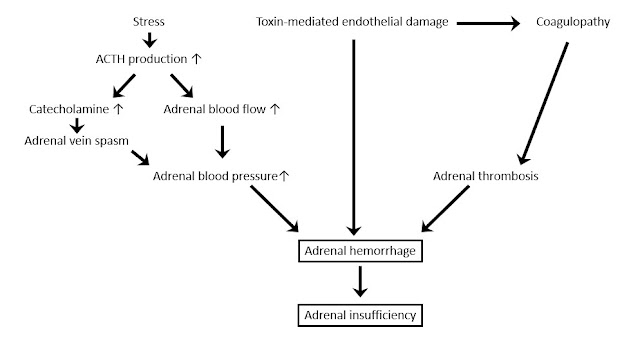Waterhouse Frederichsen syndrome
Waterhouse Frederichsen syndrome
Updated: 06/21/2022
© Jun Wang, MD, PhD
General features
- Adrenal insufficiency
- Due to bilateral/unilateral adrenal hemorrhage
- Associated with bacterial or viral infection
- Commonly associated with meningococcal infection
- Other associated pathogens include
- Haemophilus influenzae
- Pseudomonas aeruginosa
- Escherichia coli
- Streptococcus pneumoniae
Pathogenesis
Clinical presentations
- Sudden onset
- Nonspecific presentations: headache, fever, weakness, abdominal/flank pain, anorexia, etc
- Signs of shock:
Tachycardia, hypotension, etc
- Abdominal rigidity or rebound tenderness
- If associated with meningococcemia: petechial rash, purpura fulminans, other neurological abnormalities
Key Laboratory findings
- Features of Disseminated intravascular coagulation
- Leukocytosis
- Hyponatremia and hyperkalemia: Mineralocorticoid deficiency
- Hypoglycemia: glucocorticoid deficiency
- Elevated: ACTH, renin
- Decreased: Aldosterone, glucocorticoid
Radiological features
- Adrenal hemorrhage
Pathological features
Management
- Management for shock: Volume resuscitation, vasopressor, etc
- Management for sepsis: Antibiotics based on blood microbiology study results
- Other supportive managements: Treatment for hypoglycemia, hyponatremia, hyperkalemia, etc
Prognosis
- High fatality rate, especially when diagnosis and treatment are delayed
Back to contents

Comments
Post a Comment